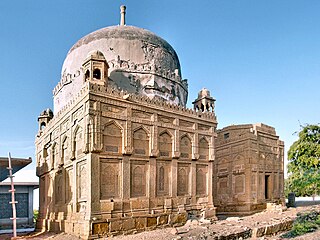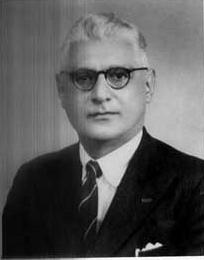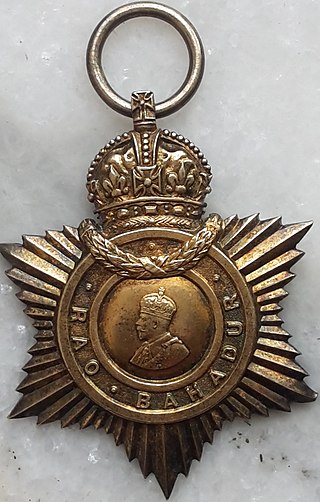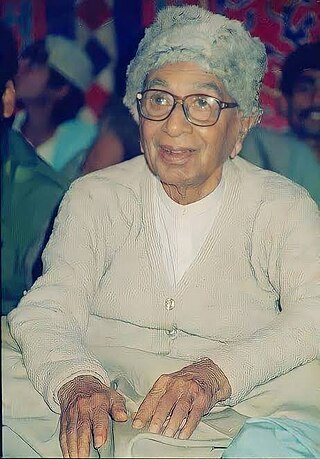Related Research Articles

Hyderabad is a city and the capital of Hyderabad Division in the Sindh province of Pakistan. It is the second-largest city in Sindh, and the eighth largest in Pakistan.

Mirpur Khas is the capital city of the Mirpur Khas District and Mirpur Khas Division in the Sindh province, Pakistan. Mirpur Khas is the 6th largest city in Sindh province and the 34th largest city of Pakistan. The city was built by Talpur rulers of Mankani branch. According to the 2017 Census of Pakistan, its population is 233,916. Mirpur Khas is known for its mango cultivation, with hundreds of varieties of the fruit produced each year - it is also called the “City of Mangoes,” and has been home to an annual mango festival since 1955. After the completion of Hyderabad-Mirpurkhas dual carriage way, the city has become hub of commercial activities.

Ahmed Ghulam Ali Chagla was a Pakistani musical composer who famously wrote the music for the national anthem of Pakistan in 1949. A scholar and writer, he was also an active member of the Theosophical Society.

Rao Bahadur and Rai Bahadur, abbreviatedR.B., was a title of honour bestowed during British rule in India to individuals for faithful service or acts of public welfare to the Empire. From 1911, the title was accompanied by a medal called a Title Badge. Translated, Rao means "prince", and Bahadur means "brave" or "most honourable". Bestowed mainly on Hindus, the equivalent title for Muslim and Parsi subjects was Khan Bahadur. For Sikhs it was Sardar Bahadur.

The Hindu Gymkhana is a colonial-era building located on Sarwar Shaheed Road in Karachi, Pakistan. It was the first public building in Karachi to adopt the Mughal-Revival architectural style. It was established in 1925 by the Karachi's Hindus as an exclusive club for their community. The building houses the National Academy of Performing Arts.
Umar Bin Mohammad Daudpota was a Sindhi researcher, historian, linguist and scholar of the Indus Valley.
Muhammad Ibrahim Joyo was a Pakistani teacher, writer, scholar and Sindhi nationalist. He was born in the village of Abad near Laki, Kotri, Dadu, now in Jamshoro, Sindh, Pakistan. He was considered the living legend of Sindhi literature, who had written, translated and edited hundreds of books and brochures. He was affiliated with the Theosophical Society.
Tando Qaiser is a town in Hyderabad District, Pakistan. It is named after the 18th-century leader of the Nizamani tribe in Sindh, Qaiser Khan Nizamani, who founded the village after his son Gulham Ali Nizamani died there whilst Qaiser, his younger brother, Aloda and their forces were moving north to their original home of Dera Ghazi Khan in Southern Punjab. Tando means 'fortified settlement' and indicates the original settlement founded by Qaiser was a militarily fortified settlement.
Ustad Muhammad Juman was a Sindhi musician and classical singer from Pakistan, whose impact on Sindhi music is still pervasive.
Sir Ghulam Hussain Hidayatullah KCSI was a colonial Indian and Pakistani politician from Sindh. He held several offices in Sindh including 1st Chief Minister (1937–1938) and being re-elected as 5th Chief Minister (1942–1947).
Allah Bux Muhammad Umar Soomro, or Allah Baksh Soomro, was a zamindar, government contractor, Indian independence activist and politician from the province of Sindh in colonial India. He is considered to be amongst the best premiers of the province, known for promoting Hindu-Muslim unity and campaigning for an independent, united India. He was referred to as Shaheed or "martyr".

Ghulam Murtaza Syed, known as G. M. Syed was a prominent Sindhi politician, who is known for his scholarly work, passing only constitutional resolution in favor of the establishment of Pakistan from British India's Sindh Assembly in 1943. Later proposing ideological groundwork for separate Sindhi identity and laying the foundations of Sindhudesh movement. He is regarded as one of the founding fathers of modern Sindhi nationalism.
Manjhand is a small village in the district of Jamshoro. The population of the village is estimated to be between 800 and 900. The population contains a heavy part of the Lanjar, Khosa, khaskheli, Panhwar, Mir Bahar (Mallah), and Baladi tribes. It is situated beside the Unarpur railway station and is two kilometers from the right bank of Indus River. The village also has a rich schooling system. The Department of Education and Literacy - Sindh has established primary schools for girls and boys in Manjhand.
Harchandrai Vishandas C.I.E., was a British Indian attorney, politician, and mayor of Karachi in modern-day Pakistan. He is considered a great Sindhi and “the father of modern Karachi.” His social, educational, and political services rendered to the people of Sindh are so great that he is now recognised as one of the makers of modern Karachi.

Sindhi Hindus are Sindhis who follow the Hindu religion, whose origins lie in the Sindh region and spread across modern-day India and the Pakistani Sindh province. After the Partition of India in 1947, many Sindhi Hindus were among those who fled from Pakistan to the dominion of India, in what was a wholesale exchange of Hindu and Muslim populations in some areas. Some later emigrated from the subcontinent and settled in other parts of the world.

The Insurgency in Sindh is a low-intensity insurgency waged by Sindhi Nationalists against the government of Pakistan. Sindhi nationalists want to create an independent state called Sindhudesh.However, this movement never gained support from the populace of urban Sindh.
Hussain Bakhsh Khadim also spelt as Hussain Bux Khadim, was a Sindhi language folk singer and poet.
Seth Sukhdev Udhavdas was a Sindhi landlord and anti-colonial politician associated with the Indian National Congress. After partition, he chose to stay in Pakistan and allied with the Pakistan National Congress. In July 1949, Sukhdev was inducted as the non-Muslim representative of Sindh in the Constituent Assembly of Pakistan since Jairamdas Daulatram —the erstwhile representative in the Constituent Assembly of India on a Congress ticket— chose to stay in India.
References
- ↑ Khadim Hussain Soomro (2001). Seth Harchandrai Vishandas. Sain Publishers, 2001 original from the University of Michigan. p. 13.
- ↑ They Too Fought for India's Freedom: The Role of Minorities. edited by Asgharali Engineer. 2006. p. 218. ISBN 9788178710914.